Cognos Query_studio
- 格式:pdf
- 大小:1.07 MB
- 文档页数:80
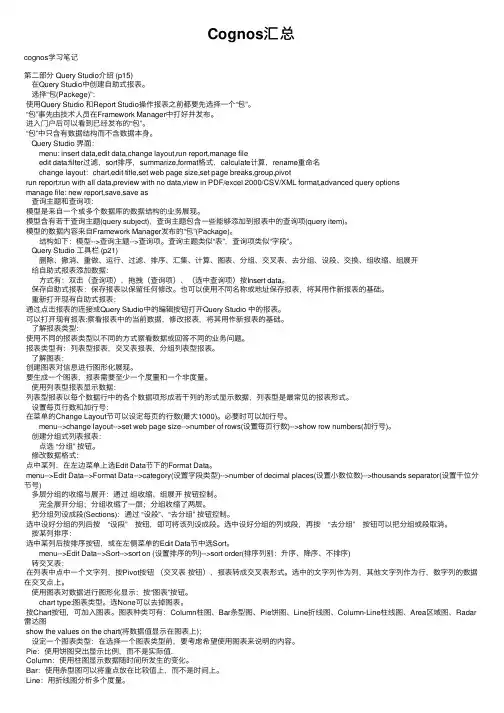
Cognos汇总cognos学习笔记第⼆部分 Query Studio介绍 (p15)在Query Studio中创建⾃助式报表。
选择“包(Packege)”:使⽤Query Studio 和Report Studio操作报表之前都要先选择⼀个“包”。
“包”事先由技术⼈员在Framework Manager中打好并发布。
进⼊门户后可以看到已经发布的“包”。
“包”中只含有数据结构⽽不含数据本⾝。
Query Studio 界⾯:menu: insert data,edit data,change layout,run report,manage fileedit data:filter过滤,sort排序,summarize,format格式,calculate计算,rename重命名change layout:chart,edit title,set web page size,set page breaks,group,pivotrun report:run with all data,preview with no data,view in PDF/excel 2000/CSV/XML format,advanced query optionsmanage file: new report,save,save as查询主题和查询项:模型是来⾃⼀个或多个数据库的数据结构的业务展现。
模型含有若⼲查询主题(query subject),查询主题包含⼀些能够添加到报表中的查询项(query item)。
模型的数据内容来⾃Framework Manager发布的“包”(Package)。
结构如下:模型-->查询主题-->查询项。
查询主题类似“表”,查询项类似“字段”。
Query Studio ⼯具栏 (p21)删除、撤消、重做、运⾏、过滤、排序、汇集、计算、图表、分组、交叉表、去分组、设段、交换、组收缩、组展开给⾃助式报表添加数据:⽅式有:双击(查询项),拖拽(查询项)、(选中查询项)按Insert data。
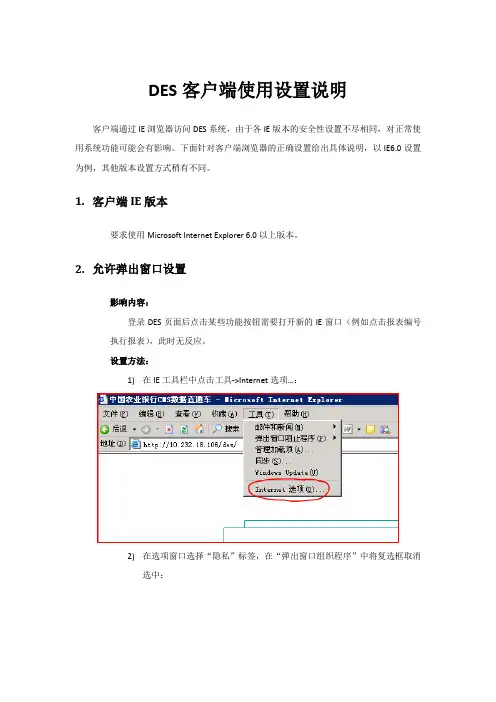
DES客户端使用设置说明客户端通过IE浏览器访问DES系统,由于各IE版本的安全性设置不尽相同,对正常使用系统功能可能会有影响。
下面针对客户端浏览器的正确设置给出具体说明,以IE6.0设置为例,其他版本设置方式稍有不同。
1.客户端IE版本要求使用Microsoft Internet Explorer 6.0以上版本。
2.允许弹出窗口设置影响内容:登录DES页面后点击某些功能按钮需要打开新的IE窗口(例如点击报表编号执行报表),此时无反应。
设置方法:1)在IE工具栏中点击工具->Internet选项…:2)在选项窗口选择“隐私”标签,在“弹出窗口组织程序”中将复选框取消选中:3)如果希望仍然限制其他站点的弹出窗口,可在上一页面中仍然选中复选框,点击“设置”按钮,在输入地址的编辑框中输入DES登录页面的地址,并点击“添加”按钮:4)点击关闭完成设置。
3.信任站点设置影响内容:打开DES登录页面图片和输入框显示不正常;在DES登录页面输入正确的用户和密码后页面不跳转,返回登录页面;登录DES页面后在打开的新窗口中提示输入用户名和密码。
设置方法:1)在IE工具栏中点击工具->Internet选项…:2)在选项窗口选择“安全”标签,选中“受信任的站点”,再点击站点按钮:3)在输入网址的编辑框中输入所有服务器的地址依次添加,包括DES的应用服务器和报表服务器(包括集群的服务器地址),将窗口中的复选框取消选择,再点击添加按钮:4)点击关闭和确定后完成设置。
重新刷新页面。
4.隐私站点设置影响内容:登录DES页面后在打开的新窗口中提示输入用户名和密码。
设置方法:1)在IE工具栏中点击工具->Internet选项…:2)在选项窗口选择“隐私”标签,点击站点按钮:3)在输入网址的编辑框中输入所有报表服务器的地址依次添加(包括集群的服务器地址),再点击允许按钮:4)点击确定后完成设置。
关闭IE重新登录DES系统。
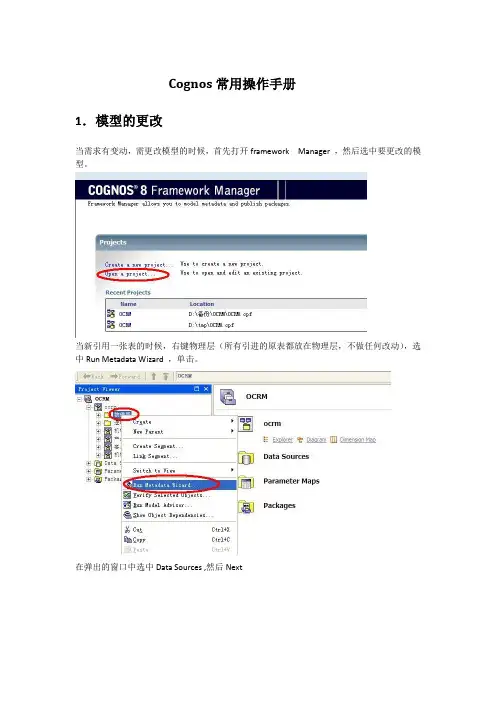
Cognos常用操作手册1.模型的更改当需求有变动,需更改模型的时候,首先打开framework Manager ,然后选中要更改的模型。
当新引用一张表的时候,右键物理层(所有引进的原表都放在物理层,不做任何改动),选中Run Metadata Wizard ,单击。
在弹出的窗口中选中Data Sources ,然后Next选中数据源,单击Next选中OCRMINST展开,展开后选中所要添加表的表名选中后,选择下面的的第一项import and create a unique name ,点击确定去掉前面的钩,不把表所带的任何关系引进来(一般都是引进表之后,自己建立关系)点击import后,导入之后点击finish。
这样就完成表的导入。
接下来完成对表的汉化(翻译),右键逻辑层(对表进行一些加工,抽取有用的字段,过滤所需要的数据等等)选择creat—>Query Subject。
填写表名,单击ok点击后拖拽到右边即可,选好后ok。
如果要对某个字段进行加工计算时(如通过汇率转换币种),单击右下角的add填写字段名称,选好加工字段后,左边的标签切换到Funotions(一些常用的函数),个字段也可以直接翻译。
接下来是展示层(就是打包后能给报表制作人员看的部分),首先在根目录ocrm下,右键create—>Namespace(这是在建模型时为了划分不同的主题,而建多个namespace,但是如果添加的表属于某个名字空间下,那么直接加到他的目录下,不用新建一个新的namespace。
如果是要单独成立一个主题,那么就需要新建一个namespace),建好namespace或选好namespace后,右键单击新建一个Query Subject,之后的步骤跟上面在逻辑层汉化一张表的步骤一样,唯一不同的就是不需要再进行一次汉化了。
这样一张新表从数据源中就引到模型中,进行了汉化和展示。
2.表与表之间建立关系选中两张要建关系的表,右键单击选中Create Relationship,选好相关联的字段,和关系类型(1:1&1:n&n:1…)确定3.切换的数据源如果数据源改变,模型也可以切换数据源,但要保证所切换的数据源要有与模型里的表相同的表名。
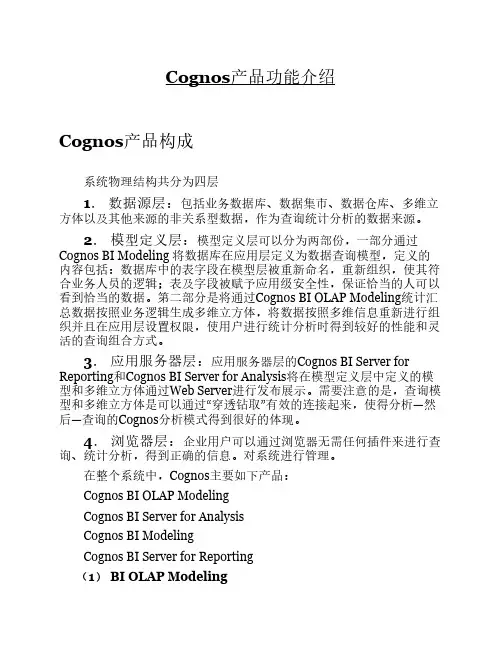
Cognos产品功能介绍Cognos产品构成系统物理结构共分为四层1.数据源层:包括业务数据库、数据集市、数据仓库、多维立方体以及其他来源的非关系型数据,作为查询统计分析的数据来源。
2.模型定义层:模型定义层可以分为两部份,一部分通过Cognos BI Modeling 将数据库在应用层定义为数据查询模型,定义的内容包括:数据库中的表字段在模型层被重新命名,重新组织,使其符合业务人员的逻辑;表及字段被赋予应用级安全性,保证恰当的人可以看到恰当的数据。
第二部分是将通过Cognos BI OLAP Modeling统计汇总数据按照业务逻辑生成多维立方体,将数据按照多维信息重新进行组织并且在应用层设置权限,使用户进行统计分析时得到较好的性能和灵活的查询组合方式。
3.应用服务器层:应用服务器层的Cognos BI Server for Reporting和Cognos BI Server for Analysis将在模型定义层中定义的模型和多维立方体通过Web Server进行发布展示。
需要注意的是,查询模型和多维立方体是可以通过“穿透钻取”有效的连接起来,使得分析—然后—查询的Cognos分析模式得到很好的体现。
4.浏览器层:企业用户可以通过浏览器无需任何插件来进行查询、统计分析,得到正确的信息。
对系统进行管理。
在整个系统中,Cognos主要如下产品:Cognos BI OLAP ModelingCognos BI Server for AnalysisCognos BI ModelingCognos BI Server for Reporting(1) BI OLAP ModelingBI OLAP Modeling是Cognos提供的企业级OLAP 模型设计工具,它将从各类数据源(数据库、数据仓库、平面文件)中筛选出来的数据创建成多维数据立方体。
立方体是按探察业务的OLAP多维因素分析模型的设计创建,通过对多维数据立方体的OLAP分析,用户可以辨明趋势、跟踪业务运作、创建高效的统计汇总报表。
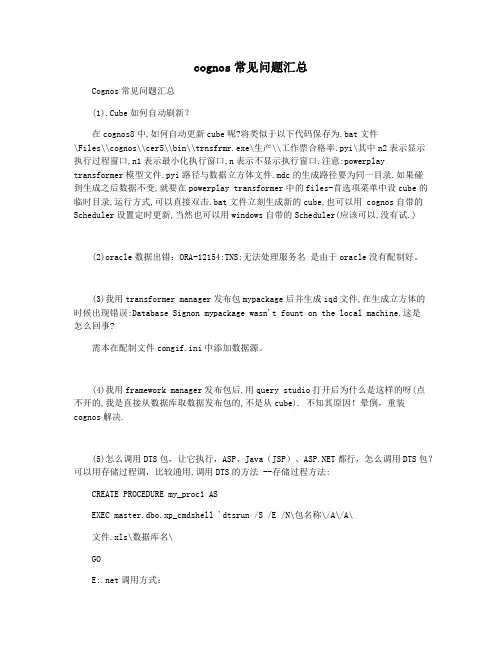
cognos常见问题汇总Cognos常见问题汇总(1).Cube如何自动刷新?在cognos8中,如何自动更新cube呢?将类似于以下代码保存为.bat文件\Files\\cognos\\cer5\\bin\\trnsfrmr.exe\生产\\工作票合格率.pyi\其中n2表示显示执行过程窗口,n1表示最小化执行窗口,n表示不显示执行窗口.注意:powerplay transformer模型文件.pyi路径与数据立方体文件.mdc的生成路径要为同一目录.如果碰到生成之后数据不变,就要在powerplay transformer中的files-首选项菜单中设cube的临时目录,运行方式,可以直接双击.bat文件立刻生成新的cube,也可以用 cognos自带的Scheduler设置定时更新,当然也可以用windows自带的Scheduler(应该可以,没有试.)(2)oracle数据出错:ORA-12154:TNS:无法处理服务名是由于oracle没有配制好。
(3)我用transformer manager发布包mypackage后并生成iqd文件,在生成立方体的时候出现错误:Database Signon mypackage wasn't fount on the local machine.这是怎么回事?需本在配制文件congif.ini中添加数据源。
(4)我用framework manager发布包后,用query studio打开后为什么是这样的呀(点不开的,我是直接从数据库取数据发布包的,不是从cube). 不知其原因!晕倒,重装cognos解决.(5)怎么调用DTS包,让它执行,ASP、Java(JSP)、都行,怎么调用DTS包?可以用存储过程调,比较通用,调用DTS的方法 --存储过程方法:CREATE PROCEDURE my_proc1 ASEXEC master.dbo.xp_cmdshell 'dtsrun /S /E /N\包名称\/A\/A\文件.xls\数据库名\GOE:.net调用方式://说明需要添加 Microsoft.SqlServer.DTSPkg80.Package2Class ////// 运行DTS(Data Transformation Services )////// public string runDTS() { try {string returnValue;Microsoft.SqlServer.DTSPkg80.Package2Class package = newMicrosoft.SqlServer.DTSPkg80.Package2Class(); string fileName = \string password = null; string packageID = null; string versionID = null; string name = \object pVerpersistStfOfHost = null;package.LoadFromStorageFile(fileName,password,packageID,versionID,name,refpVerpersistStfOfHost); package.Execute(); package.UnInitialize();package=null;returnValue = \return returnValue; }catch(Exception ex) {throw ex; } }(6)如何使用模板技术?参照Report Studio的快速入门教程。
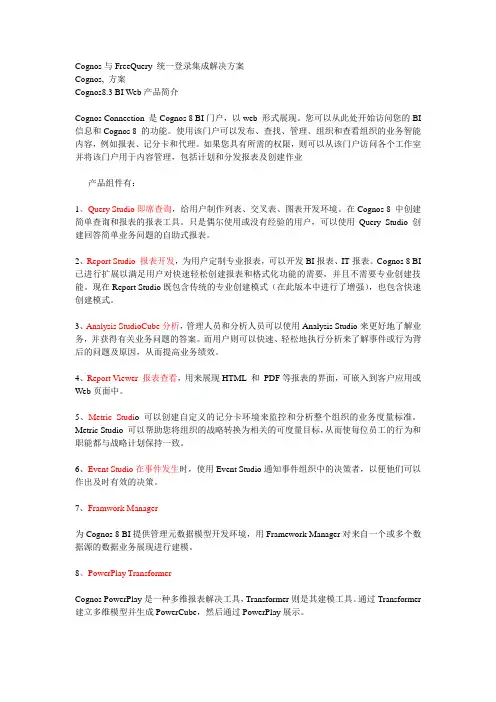
Cognos与FreeQuery 统一登录集成解决方案Cognos, 方案Cognos8.3 BI Web产品简介Cognos Connection 是Cognos 8 BI门户,以web 形式展现。
您可以从此处开始访问您的BI 信息和Cognos 8 的功能。
使用该门户可以发布、查找、管理、组织和查看组织的业务智能内容,例如报表、记分卡和代理。
如果您具有所需的权限,则可以从该门户访问各个工作室并将该门户用于内容管理,包括计划和分发报表及创建作业产品组件有:1、Query Studio即席查询,给用户制作列表、交叉表、图表开发环境。
在Cognos 8 中创建简单查询和报表的报表工具。
只是偶尔使用或没有经验的用户,可以使用Query Studio 创建回答简单业务问题的自助式报表。
2、Report Studio 报表开发,为用户定制专业报表,可以开发BI报表、IT报表。
Cognos 8 BI 已进行扩展以满足用户对快速轻松创建报表和格式化功能的需要,并且不需要专业创建技能。
现在Report Studio既包含传统的专业创建模式(在此版本中进行了增强),也包含快速创建模式。
3、Analysis StudioCube分析,管理人员和分析人员可以使用Analysis Studio来更好地了解业务,并获得有关业务问题的答案。
而用户则可以快速、轻松地执行分析来了解事件或行为背后的问题及原因,从而提高业务绩效。
4、Report Viewer 报表查看,用来展现HTML 和PDF等报表的界面,可嵌入到客户应用或Web页面中。
5、Metric Studi o可以创建自定义的记分卡环境来监控和分析整个组织的业务度量标准。
Metric Studio 可以帮助您将组织的战略转换为相关的可度量目标,从而使每位员工的行为和职能都与战略计划保持一致。
6、Event Studio在事件发生时,使用Event Studio通知事件组织中的决策者,以便他们可以作出及时有效的决策。

Cognos介绍与应用目录contents•Cognitive Cognos•Cognos Core Components •Application of Cognos in DataAnalysis•The Value of Cognos in Business Intelligence•Cognos Implementation and Deployment Precautions•Cognos training support and after sales service01CognitiveCognosCognos Definition and FunctionalityDefinitionCognos is a business intelligence and performancemanagement software suite that provides reporting,analysis, dashboard, scoring, and event managementcapabilitiesFunctionalityCognos enables organizations to transform data intoinsights and make informed decisions by providingtools for data integration, modeling, visualization, andcollaborationDevelopment history and market positionDevelopment historyCognos was founded in the 1960s and has since grown to become aleading provider of business intelligence solutions Over the years, it hasacquired several companies and technologies to enhance its productoffersMarket positionCognos is a well recognized brand in the business intelligence market,known for its robust functionality, scalability, and ease of use It competeswith other leading BI vendors such as Tableau, Power BI, and QlikViewCognos is widely used in various industries such as finance, healthcare, retail, manufacturing, and government It can be applied to areas such as financial reporting, operational analysis, market research, and customer relationship managementApplication fields Some of the key advantages of using Cognosinclude its ability to handle large volumes of data, provide real-time analytics, support collaborative decision making, and offer a wide range of customization options Additionally, its intuitive interface and drag and dropfunctionality make it easy for users to create and share reports and dashboardsAdvantagesApplication fields and advantages02Cognos CoreComponentsReport Studio Report DesignIntuitive report design interfaceEnable users to create pixel perfect reports with a drag and drop interface,providing full control over report layout and formattingData visualizationIncorporates charts, graphs, and other visual elements to enhance datapresentation and understandingInteractive reportingSupports drill down, filtering, and sorting capabilities to enable users to interactwith and explore data dynamicallyQuery Studio Data QueryPowerful data query toolAllow users to retrieve data from multiple sources,including relational databases, cubes, and other datarepositoriesIntrinsic query builderProvides a graphical interface for building complexqueries without requiring extensive knowledge ofSQL or other query languagesReal time data accessEnable users to run queries and view results in realtime, facilitating fast decision makingAnalysis Studio data analysisAdvanced analyticsProvides a range of statistical andpredictive analytics tools to helpusers gain deeper insights intotheir dataData visualizationUtilize charts, graphs, and othervisual aids to simplify complexdata sets and highlight key trendsand patternsInteractive analysis Supports ad hoc analysis anddata exploration through dragand drop functionality anddynamic filteringEvent Studio event handlingEvent driven architecture01Enable real-time event handling and response, allowing users totrigger actions based on specific events or conditionsCustomized event rules02Provide a flexible framework for defining event rules andresponses, enabling users to detail the system to their specificneedsIntegration with other systems03Facilities integration with external systems and applications toenable seamless event handling and automation of businessprocesses03Application ofCognos in DataAnalysisData source connection and integrationConnect to multiple data sourcesCognos can connect to various data sources such as relational databases,multi-dimensional databases, and data warehousesData integrationIt can integrate data from different sources and transform them into a unifiedformat for analysisData virtualizationCognos provides data virtualization technology, which can integrate multipledata sources into a virtual data layer for easier data access and analysisData cleaningCognos provides data cleaning functions such as data deduplication, missing value filling, and outlier processing to ensure data qualityIt can convert data fromdifferent formats andstructures into a unifiedformat for analysis, such asconverting text data intonumerical dataCognos also provides datatransformation functionssuch as data aggregation,calculation, and filtering tomeet different analysisneedsDataconversionDatatransformationData cleaning and conversionData visualization displayDiverse chart typesCognos supports a variety of chart types such as barcharts, line charts, pie charts, scatter plots, etc., whichcan visually display data and enhance understandingInteractive visualizationIt provides interactive visualization functions such asdrill down, slicing and dicing, and filtering, allowingusers to explore data more deeplyDashboard customizationUsers can customize dashboards according to theirneeds, combining different charts and widgets todisplay key indicators and analysis resultsReport designCognos provides a report designer tool that allows users to design reports with a variety of layouts and formats Interactive reportsIt supports interactive reports,which can be viewed andanalyzed in real time based onuser input and selectionsReport schedulingand distributionUsers can schedule reportgeneration and distribution tasks,automatically sending reports tospecific recipients via email orother channels010203 Interactive report production04The Value ofCognos inBusinessIntelligenceImprove decision making efficiency and accuracy•Provide comprehensive data analysis and visualization tools: Cognos offers a variety of data analysis and visualization functions, such as charts, graphs, and dashboards, which can help users quickly understand market trends, customer needs, and business situations•Real time data monitoring and alerting: With Cognos, users can set up real-time data monitoring and alerting mechanisms to track key business indicators and receive timely notifications when data changes occur, enabling faster and more accurate decision making•Data driven predictive analysis: By leveraging historical data and advanced algorithms, Cognos can help users predict future trends and outcomes, providing valuable insights for strategic planning and decision makingAutomated routing tasks and workflows: Cognos can automate routing data collection, processing, and reporting tasks, freeing up human resources for more value added work and reducing operational costs Optimize resource allocation:Through data analysis, Cognoscan help enterprises identifyefficient or redundant processesand resources, enabling morerational allocation of resourcesand cost savingsImprove collaboration andcommunication efficiency: Withits powerful collaboration andsharing functions, Cognos canfacilitate better communicationand collaboration betweendepartments and teams,improving overall businessefficiency010203 Optimize business processes and reduce costsEnhance enterprise competitiveness and innovation capability•Gain insights into market and competitor information: By analyzing external data sources such as market research reports and competitor information, Cognos can help enterprises gain a deep understanding of market trends and competitor strategies, enabling more targeted business decisions•Foster a data-driven culture of innovation: With easy access to data and insights provided by Cognos, enterprises can cultivate a culture of data-driven innovation where employees are resourced to explore new ideas and opportunities based on data insights•Accelerate product development and market launch: By leveraging data insights from Cognos, enterprises can identify customer needs and preferences more accurately and develop products that better meet market demands, then accelerate product development cycles and time to market05CognosImplementation andDeploymentPrecautionsSystem environment setup requirementsOperating SystemEnsure compatibility with the Cognos software, such asWindows, Linux, or UnixHardware RequirementsAdequate memory, storage, and processing power to supportCognos operationsNetwork ConfigurationPropose network setup to allow for effective data transmissionand accessDatabase ConnectivityEnsure seamless integration with variable databases for dataretrieval and storageUser permission setting policyRole Based Access Control (RBAC)Implement RBAC to manage user permissions and restrictaccess to sensitive data and functionsUser AuthenticationUtilize secure authentication mechanisms to verify useridentity and prevent unauthorized accessPermission LevelsDefine different permission levels for users based on theirroles and responsibilities within the organizationRegular AuditingConduct regular audits to monitor user activity and detect anysuspicious or unauthorized behaviorData security measuresEncryptionApply encryption techniques toprotect sensitive data both during transmission and at restAccess Controls Implement strict access controls to prevent unauthorized users from accessing or modifying dataData MaskingUse data masking to hide sensitive information from unauthorized users while maintaining data integrityBackup and Recovery Establish robust backup andrecovery mechanisms to ensure data availability in case of disasters or failures06Cognostrainingsupport andafter salesservice1 2 3Offers a variety of training materials, including video tutorials, user guides, and webinarsCognos Official WebsiteCognos has a team of certified trainers who provide in person and online training coursesCertified TrainersCognos partners with several training organizations to offer a wide range of courses and certificatesTraining PartnersIntroduction to Official Training ResourcesGuidelines for Using Online Learning Platforms •Access to Online Courses: Customers can ACTHANKS感谢观看。
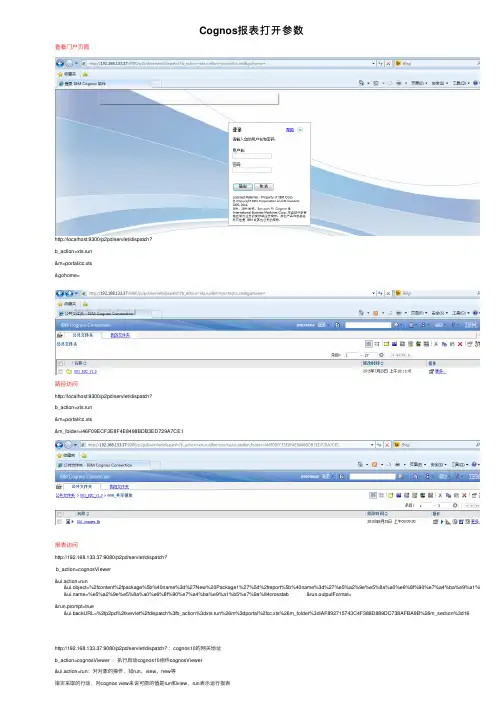
Cognos报表打开参数查看门户页⾯http://localhost:9300/p2pd/servlet/dispatch?b_action=xts.run&m=portal/cc.xts&gohome=路径访问http://localhost:9300/p2pd/servlet/dispatch?b_action=xts.run&m=portal/cc.xts&m_folder=i46F09ECF3E8F4E8498BDB3ED729A7CE1报表访问http://192.168.133.37:9080/p2pd/servlet/dispatch?b_action=cognosViewer&ui.action=run&ui.object=%2fcontent%2fpackage%5b%40name%3d%27New%20Package1%27%5d%2freport%5b%40name%3d%27%e5%a2%9e%e5%8a%a0%e6%8f%90%e7%a4%ba%e9%a1%b5%e7%9a &=%e5%a2%9e%e5%8a%a0%e6%8f%90%e7%a4%ba%e9%a1%b5%e7%9a%84crosstab &run.outputFormat=&run.prompt=true&ui.backURL=%2fp2pd%2fservlet%2fdispatch%3fb_action%3dxts.run%26m%3dportal%2fcc.xts%26m_folder%3diAF892715743C4F388D889DC738AFBA9B%26m_section%3d16http://192.168.133.37:9080/p2pd/servlet/dispatch? :cognos10的⽹关地址b_action=cognosViewer :执⾏启动cognos10组件cognosViewer&ui.action=run:对对象的操作,如run、view、new等指定采取的⾏动,对cognos view来说可能的值是run和view,run表⽰运⾏报表&ui.object=%2fcontent%2fpackage%5b%40name%3d%27New%20Package1%27%5d%2freport%5b%40name%3d%27%e4%ba%a7%e5%93%81%e5%ad%a3%e5%ba%a6%e9%94%80%e5%94%a 指定要打开的报表等组件的(包,报表等对象)搜索路径(search path)。
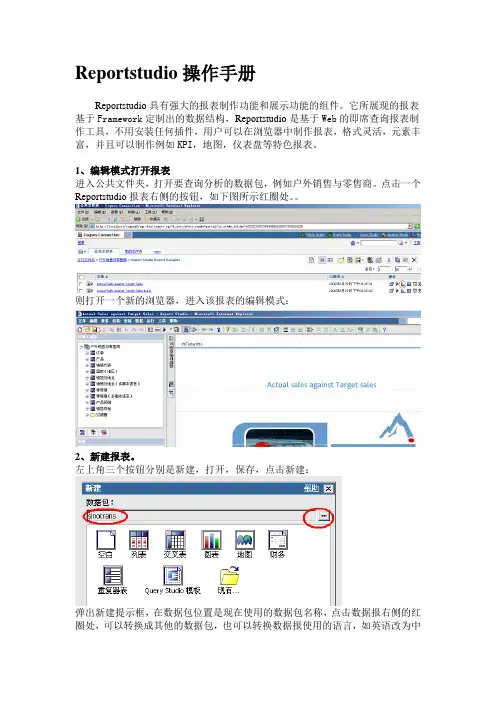
Reportstudio操作手册Reportstudio具有强大的报表制作功能和展示功能的组件。
它所展现的报表基于Framework定制出的数据结构,Reportstudio是基于Web的即席查询报表制作工具,不用安装任何插件,用户可以在浏览器中制作报表,格式灵活,元素丰富,并且可以制作例如KPI,地图,仪表盘等特色报表。
1、编辑模式打开报表进入公共文件夹,打开要查询分析的数据包,例如户外销售与零售商。
点击一个Reportstudio报表右侧的按钮,如下图所示红圈处。
则打开一个新的浏览器,进入该报表的编辑模式:2、新建报表。
左上角三个按钮分别是新建,打开,保存,点击新建:弹出新建提示框,在数据包位置是现在使用的数据包名称,点击数据报右侧的红圈处,可以转换成其他的数据包,也可以转换数据报使用的语言,如英语改为中文。
新建的表样格式有空白,列表,交叉表,图表等等,使用熟练以后可以新建一个空白表,然后把需要的插件,如列表,交叉表,图表等手工加入进来。
下面我们以新建一个空白表为例子,选择空白,点确定:如上图,默认可插入对象选择深红色圈处“来源”,表示在可插入对象一栏显示现在数据包中已经定义好的数据。
点中第二个红圈处“数据项”时,可插入对象栏显示现在报表查询中已经有的数据项,第三个红圈处是“工具箱”。
左下角是属性栏目,表示当前选中对象的属性,一般包括条件,方框,颜色背景,字体等,当然,不同的对象有着各自不同的属性,上图中选中的区域为空白区域。
3、创建页眉,创建页脚,加标题。
1、创建页眉选中空白区域后,右上角红圈处分别为,给列表加页眉页脚,创建页眉,创建页脚。
点击创建页眉,如下图所示,页眉有了以后,选中工具箱:2、创建标题在工具箱里选中文本项目,拖动它到右侧的页眉里面。
如下图所示:单击选中“双击以编辑文本”,则左下角属性栏里显示该文本项目的属性,可以双击以编辑文本,也可以在属性栏目中红圈部分点开,编辑要显示的文本。
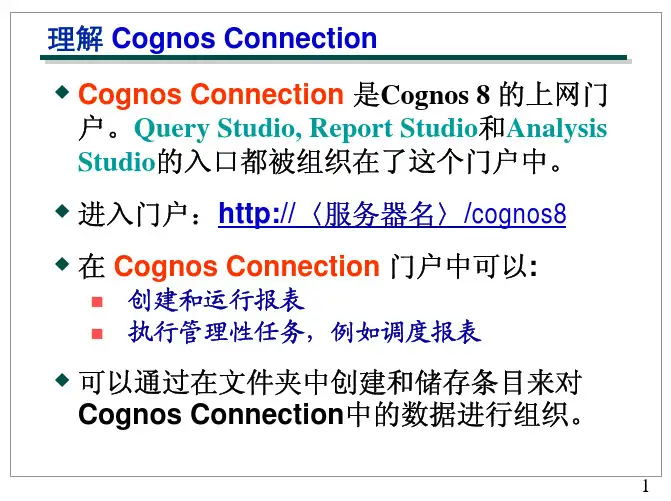
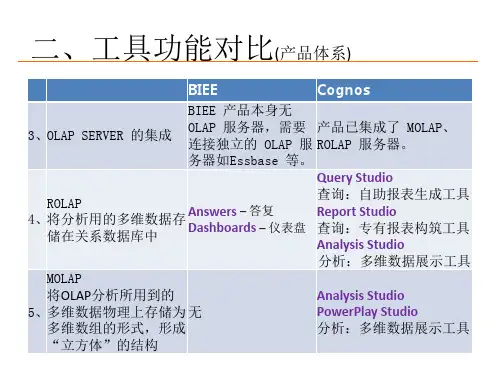
在Cognos内容存储表是第一次启动cognos服务的时候创建的,主要存储的是所有你的文件夹,报告和安全信息。
建议定期备份内容库。
表名 DescritionCMSYSPROPS该表的内容存储版本。
CMOBJNAMES该表中所有内容存储对象的名称。
CMOBJPROPS1用户,角色\群分布名单和联系方式,如电子邮件,电话号码,传真给定的名称等信息存储在此表CMOBJPROPS2报告调度信息的存储方式。
此表有像小时领域,日等一周CMOBJPROPS3商店屏幕提示,并在创建对象的描述提供的对象都存储在这里CMOBJPROPS4存储打印机纸张设置一样的高度和A3中,A4,信纸和11X17纸张宽度方向的细节CMOBJPROPS6拥有的发布的所有使用FM包的细节。
CMOBJPROPS7此表存储了所有的报表和模型的XML。
这基本上是维持有关的报告和模型的结构元数据。
CMOBJPROPS10联系信息存储在此表中。
此表也有类似联系的电子邮件和联系人列。
CMOBJPROPS11该表存储的数据源,如连接字符串配置的详细信息,立方体等位置CMOBJPROPS13它存储的参数传递给区域名称提示CMOBJPROPS14有更多的细节方面的版本,在内容创建存储对象的时间等。
CMOBJPROPS16此表提供了如LogService,MonitorService,ReportService,SystemServ ice,JobService Cognos公司的多种服务的状态CMOBJPROPS17存储每个人都“查询室,分析室,活动室”等组件的性能细节CMOBJPROPS18该表存储从源钻路径最终目标的报告。
CMOBJPROPS20店详细情况是所有的已启用的提示报告。
也有详细的报告,这是具有默认的报表选项覆盖。
CMOBJPROPS24存储打印机配置的详细信息CMOBJPROPS25有关数据存储的对象部署,如部署文件夹,报表,文件夹中的档案目前的部署,等项目的数目CMOBJPROPS26该表存储的所有数据导入/导出在C8的过程中选择的性能,包装。
知名BI工具集成:Kingbase Smartbi与Cognos Kingbase Smartbi和IBM Cognos均为成熟的商业智能产品,支持报表、查询、多维分析、仪表盘、移动应用等功能,产品的定位及整体功能相似,也存在差别。
IBM Cognos为BI产品的元老级厂商,产品线丰富全面,在品牌、成熟度、成功案例、分析能力、界面展示以及运营维护方面都较优,是商业智能和绩效管理解决方案的全球领导者。
而Kingbase Smartbi是国产BI产品的领先者,虽然在品牌、成熟度、咨询能力等方面与Cognos相比还存在一定差距,但其具有良好的开放性,支持与Cognos 集成使用实现优势互补,为客户提供更全面的BI解决方案,让BI工具发挥更大的优势作用,为企业提供更具竞争优势的信息支持,有效帮助企业做出更好的决策。
1 Smartbi对Cognos的补充1.1 增强Cognos的Dashboard功能1、增强Dashboard的交互、关联分析。
Cognos的Dashboard中,一个界面上的每个小窗口(Portlet)是独立的,Portlet之间不能实现良好互动、传递参数、关联分析。
Smartbi Dashboard可以非常好的帮助Cognos解决这一问题,使KPI与图形、图形与图形、图形与地图之间交互、互动起来。
2、增强用户个性化体验。
Dashboard针对的是企业高层领导用户,用户在不同的时期需要监控不同的KPI。
Cognos不允许最终用户方便的对界面上Portlet位置进行调整、增/删Portlet的显示。
而Smartbi Dashboard 可以为每个用户实现展现内容个性化设置。
3、增强图形类型和Flash效果。
Smartbi可以增强Cognos的图形类型,且图形具有Flash动态效果。
1.2 增强Cognos的Report功能1、增强中国特色复杂报表的功能。
Smartbi Report采用与Excel风格的设计界面,实现各种多元关联、分片、分区的复杂格式报表。
前言:此资料提供给所有因工作、学习需要而使用Cognos,或对BI等感兴趣的初学者。
1.BI目前的发展与前景(BI基础知识)商业智能的定义及起源商业智能:又称商务智能或商业智慧;英文为Business Intelligence,简写为BI。
泛指运用现代电脑技术针对数据使用数据仓库、线上分析、数据挖掘及扩展来进行有商业价值的分析与应用。
商业智能技术提供业务的历史,目前以及预测相关讯息观点。
商业智能技术的共同功能在于提供报表、线上分析处理、数据挖掘、企业绩效管理、标杆管理、文本挖掘以及预测分析。
商业智能的目的往往在于支持更好的业务决策。
因此BI系统也可以称为决策支持系统(DSS)。
虽然商业智能一词常用于商业竞争的同义词,因为他们同时都支援决策;商业智能利用技术、过程及应用来分析绝大部分的内部结构化数据和业务流程。
同时透过商业竞争情报搜集、分析、传播资讯,或是不经由技术、应用的支持信息,并着重主要是外部但也同时是公司内部的所有源信息和数据(结构化或非结构化),以支援决策。
一份1958年的文章中,IBM研究员Hans Peter Luhn使用了‘商业智能‘一词。
他将‘智能‘定义为:以理解事实呈现相互关系的方式,指引朝向预期目标的行动。
而在1989年Howard Dresner提出保护伞理论来描述商业智能:使用以事实为基础的支持系统来增进商业决策的概念和方法;这种说法到90末还尚未普遍。
数据仓库与ETL工具数据仓库,简单来说就像一个容器(收集可访问的信息资源检索)。
有组织的存放电子数据以提供报表或分析使用。
更简单的来说数据仓库就是大量数据的集合。
数库仓库的定义着重于数据存储,数据来源已被清理、转换、分类并且可被其他管理人员和专业人士进行数据挖掘、线上分析处理、市场研究及决策分析;对于数据仓库来说,萃取、分析、转换及导入数据,以及管理数据库都是很重要的组成部份。
许多资料指出数据仓库的定义范围更大,因此广义来说数据仓库包含商业智能工具、萃取工具、存储容器内的转换及导入、原数据的管理工具等。
BI.Office与润乾报表、Cognos的对比针对XXX银行指标数据填报需求,及其他BI平台扩展性需求,BI.Office与润乾报表及Cognos的对比如下。
一、BI.Office和润乾报表的对比:1.对于指标数据填报的需求,BI.Office提供专业、完整的功能体系;润乾报表仅能提供基础性的功能。
2.作为BI前端展现平台,BI.Office的产品体系非常完整,具有灵活查询/复杂报表/多维查询/管理驾驶舱等应用;润乾报表仅具有复杂报表的功能。
3.在银行业,BI.Office的应用案例更为广泛,可以作为核心的平台软件。
二、BI.Office和Cognos的对比:1.对于指标数据填报的需求,BI.Office提供专业、完整的功能体系;Cognos没有专门的解决方案。
2.BI.Office在灵活查询功能上的优势有:a. 数据访问更为灵活b. 查询条件更易设置c. 报表之间的跳转更易实现3.BI.Office在报表功能上的优势有:a. “零”编程b. 更符合中国式的报表模型c. 可以回写数据4.BI.Office在仪表盘功能上的优势有:a.图形种类更多,展现效果更美观。
b.更好的布局功能。
c.更好的交互性BI.Office与Cognos的详细对比如下。
1.查询功能比较Cognos Query Studio和BI.Office Query的定位均是满足最终业务用户提出灵活取数的需求。
BI.Office的优势是:1.数据访问更为灵活2.查询条件更易设置3.报表之间的跳转更易实现BI.Office “可视化查询”界面Cognos Query Studio界面数据访问更为灵活Cognos 必须先用Framework Manager 制作Package,然后才能用Query Studio访问。
制作Package一般由IT技术人员完成,业务人员不能制作Package。
所以业务人员访问数据的方便性、灵活性受到一定程度的限制。